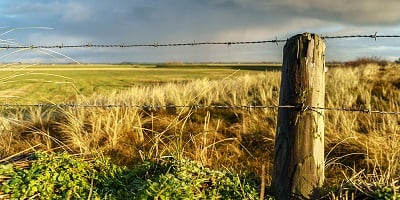Fencing can be used to keep animals in and out or protect land or crops from predators and trespassers. Adding or changing agricultural fencing around a property can seem like a daunting task, but with proper planning and the right tools, you can protect your land and your animals with an efficient, useful fence.
Why Fence Your Property?
Whether you want to keep animals inside or away from your property, fencing is an investment in protecting your land and what’s on it. Boundary fences can not only help prevent animal theft, but they also keep your animals from trespassing onto neighboring lands or from wandering away and getting lost.
Maybe you’ve been repeatedly repairing an old fence made from inadequate materials, or you are designating a new spot on your land for a certain number of livestock or crops and need to build a new, strong, appropriate fence for that area. Whatever your reason for considering building an agricultural fence, selecting the best type for your land, climate and use is important or you could end up spending a lot of time and money on an end product that doesn’t do what you want.
Which Type of Agricultural Fencing Do I Need?
Fencing is a personal choice but also you must consider the type and nature of the animals you want to keep in (or out). Split rail fencing might have an old-fashioned appeal, but is it going to protect animals like goats or sheep? Old-fashioned types of wood fencing were made from durable hardwood, whereas modern wood is softer and needs more frequent replacement. Wood is also currently in very high demand due to a boom in home construction/remodeling and can be expensive and difficult to come by. You may choose decay-resistant wood for fence posts and use wire for the fencing itself.
Consider the type and size of land to be fenced, whether the fence will be permanent or movable, the weather and climate where you live and the behavior of animals you want to keep out as well as in when deciding which type of fence is best for you.
Fence types include:
- Barbed wire (or sometimes “barb wire” or “bob wire”) is generally made from steel wire strands with periodic, sharp-edged spikes set at regular intervals. It’s relatively inexpensive and its simple construction is surprisingly effective.
- Board fencing (also “board on board”) is generally made from vertical wood boards that overlap to create a gap. This can also be made from wood composite, which has plastic in it and is less susceptible to mold, mildew, and other wood-related problems.
- Woven wire (also “box wire”) has an overlapping pattern that creates a strong yet flexible, box-shaped grid that’s difficult for animals to break.
- Mesh fence is made from two or more wire strands welded together. This is commonly used in animal cages like chicken or dog fencing.
- Cable fencing is one of the most aesthetically pleasing, as it allows for high visibility through the fence and visual appeal, so they are often used in places like patios and balconies. They can be wood, steel, or some combination of the two, but may not be as strong as other types.
- High tensile fencing is smooth metal wire and can be used in electric fencing. It’s considered the next evolution after barbed wire as it is stronger but lighter weight making it easier to install.
- Electric fence, like its name, uses electric shocks to deter animals from approaching the fence. With varying voltage, these are highly effective at keeping animals in and keeping ones out that you absolutely don’t want to get into your livestock area.
Fence Line, Post Assembly, Bracing and Stapling
After deciding what type of fence to build, you’ll want to establish your fence line and then focus on building and bracing the ends, corners and gate(s). These elements are the bedrock foundation of your fence and must be built to withstand great force and all kinds of weather.
As important as the fence material is, what type and size staples or fasteners you’ll use to secure the fencing is just as important. A fence is only as good as the fasteners, and staple pull-out can cause a dangerous and costly break in the fence. You’ll want to select a tool designed to work with pressure-treated wood that will last through heavy use, and preferably designed to work on fencing for animal pens. The FASCO® (a member of the BECK Group) F70G Fence 40-315 is a cordless gas fence stapler that has a special nose for fence application and a top-loading mag that holds 75 staples. With a speed of up to 2-3 shots per second, this tool will be a key in your wire to post fence-building arsenal, whether you’re creating fencing for cows and chickens, protecting plants in a nursery, or to protect a field of crops.
Planning + The Right Tools = Success
No matter how big or small your plot of land, fence building is a complex but important investment into protecting your property and investment. Carefully consider what will work best for your animals and your weather, and then plan the job out from top to bottom, acquiring necessary tools before you begin. The tools you use to build the fence are equal in importance to the material of the fence itself. BECK offers staplers and fasteners for every job, no matter how big or small. Download the F70G gas fence stapler brochure to learn more about this specially designed fence stapler and how it can be used for wire to post fencing.
.svg.png)


